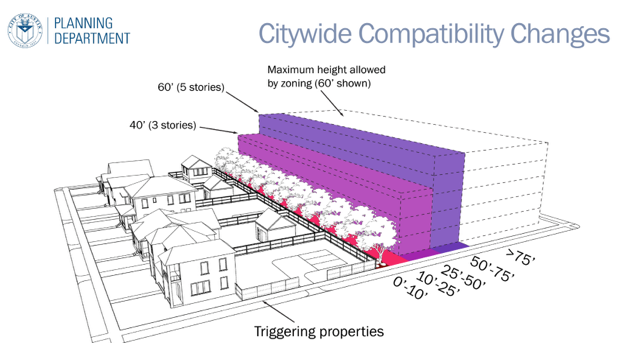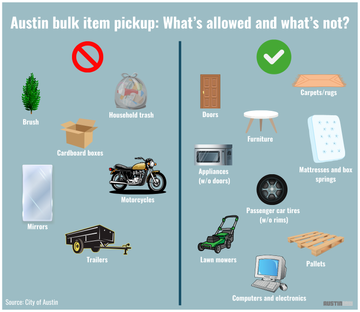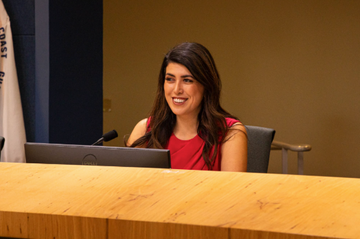☀️ Heya, Austin.
We're pullin' a Mythbusters today, y'all. The city released an image showing how new development rules would affect building height. But some folks say the image is misleading. Find out why below.
Then, check out what one of those signs means that's in everrrrybody's yard, and peep the deets behind Oracle eventually moving its HQ out of Austin.

Fact check: Is this image from the city misleading?
The city is in the process of passing several big land development code changes (catch up on all them here). The proposed changes could dramatically change parts of the city. Given that, there are plenty of proponents and critics and plenty of claims being made about what it all will mean. Today we're examining one of those claims to help you better understand what's being proposed.
The claim in question: Last week, Community Not Commodity said an image used by the city to show how proposed changes to compatibility standards would change development around single-family homes was misleading. The claim: The image showed buildings half as tall as the high-rises that could be allowed under the proposed changes.
First, what are they talking about? What are these proposed compatibility changes?
One of the proposed land development codes would change the city’s compatibility standards (i.e. the things that regulate where and how buildings can be built next to single-family homes) to end after 75 feet.
Currently, compatibility restrictions apply up to 540 feet away from a triggering property, although the current rules are not applied uniformly across the city.
So what did Community Not Commodity say?
In an email last week, CNC wrote:
“On April 8, the city’s staff released a memo with the following diagram, which claims to show the new citywide compatibility proposal.”
Here’s the image in question:
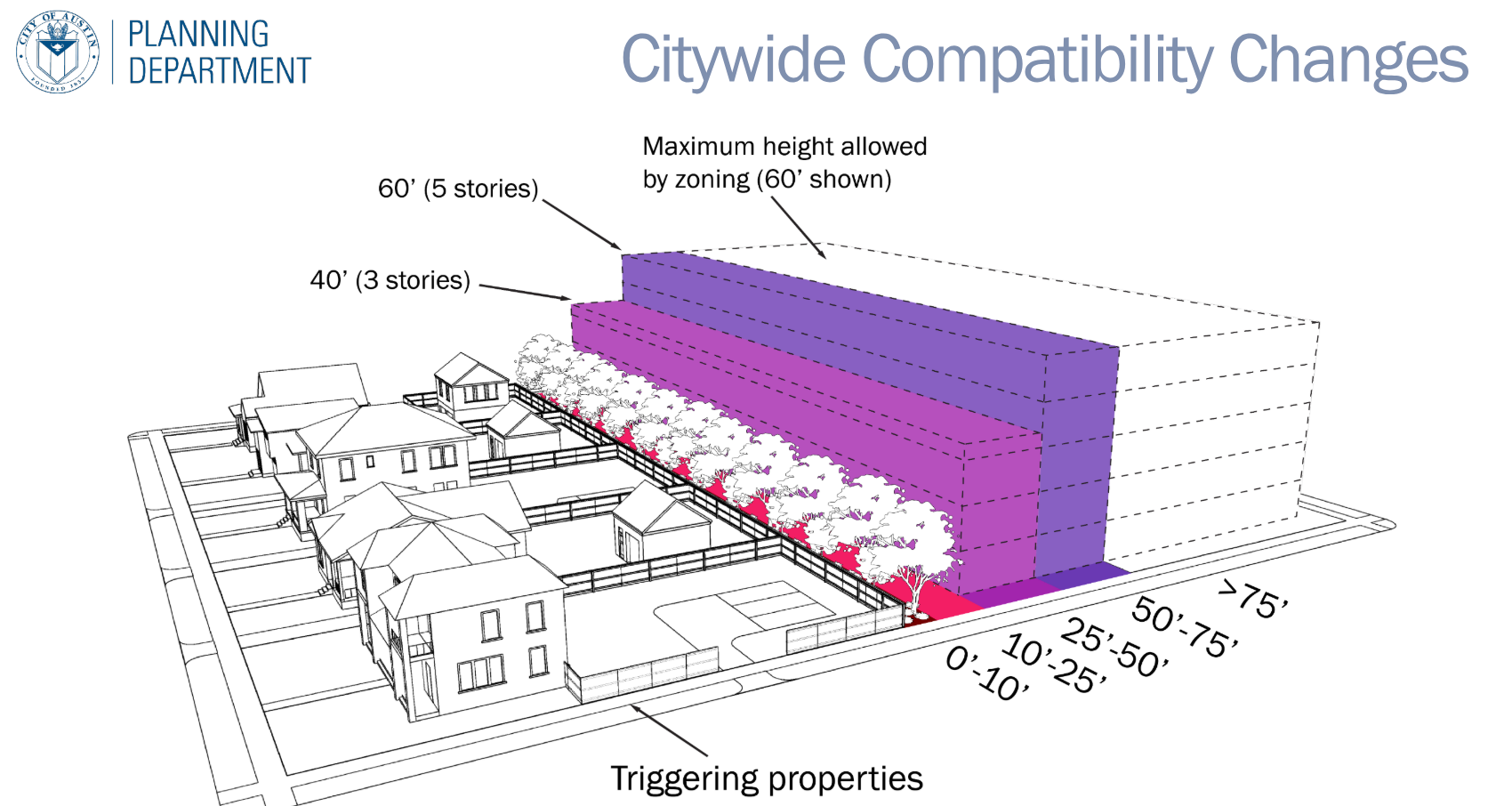
“The city is trying to mislead you: The above diagram shows buildings HALF as tall as the high-rises the new zoning classes will allow. Here's what could actually happen if that compatibility ordinance is approved.”
CNC then showed the same diagram redrawn with a building 120 feet tall after compatibility standards ended at 75 feet (the white area of the picture above).
“If the city council passes the second phase of 'H.O.M.E.NEXT', the compatibility-reduction ordinance, and the new Equitable Transit-Oriented Development rezonings on May 16, they will:
- Allow very tall buildings in close proximity to homes near commercial or multifamily property ... allowing 60 feet of additional height in some areas.”
So are they correct?
First, let's be honest, the phrasing on the diagram — "maximum height allowed by zoning (60' shown)" — might be a bit confusing to someone not familiar with the proposed changes or city zoning laws. What it means is that the building can reach whatever height is allowed by the base zoning that property is on.
However, the choice to show only a 60-foot-tall building was quite intentional.
"The visualization shows what compatibility would look like on a typical property that is subject to compatibility," a spokesperson for the city's Planning Department wrote in an email. "The maximum height allowed by zoning on most properties subject to compatibility is 60 feet, though a maximum height of 90 feet or higher may be allowed on some properties."
But there could definitely be 120-feet-tall buildings in some areas if both the compatibility and ETOD proposals pass.
In their response to questions, the city noted that an allowance for buildings up to 120 feet tall is being proposed as part of the ETOD Density Bonus Program (or DBETOD).
DBETOD projects would be allowed to develop under modified compatibility standards — specifically, between 25 and 50 feet from a triggering property buildings could be 90 feet tall (compared to the 40 feet allowed elsewhere), and after 50 feet from a triggering property no compatibility standards would apply.
So where could this happen? The ETOD designation would only apply to specific parts of the city (namely, areas that are within a half-mile of the proposed light rail line, shown in blue on the map below).
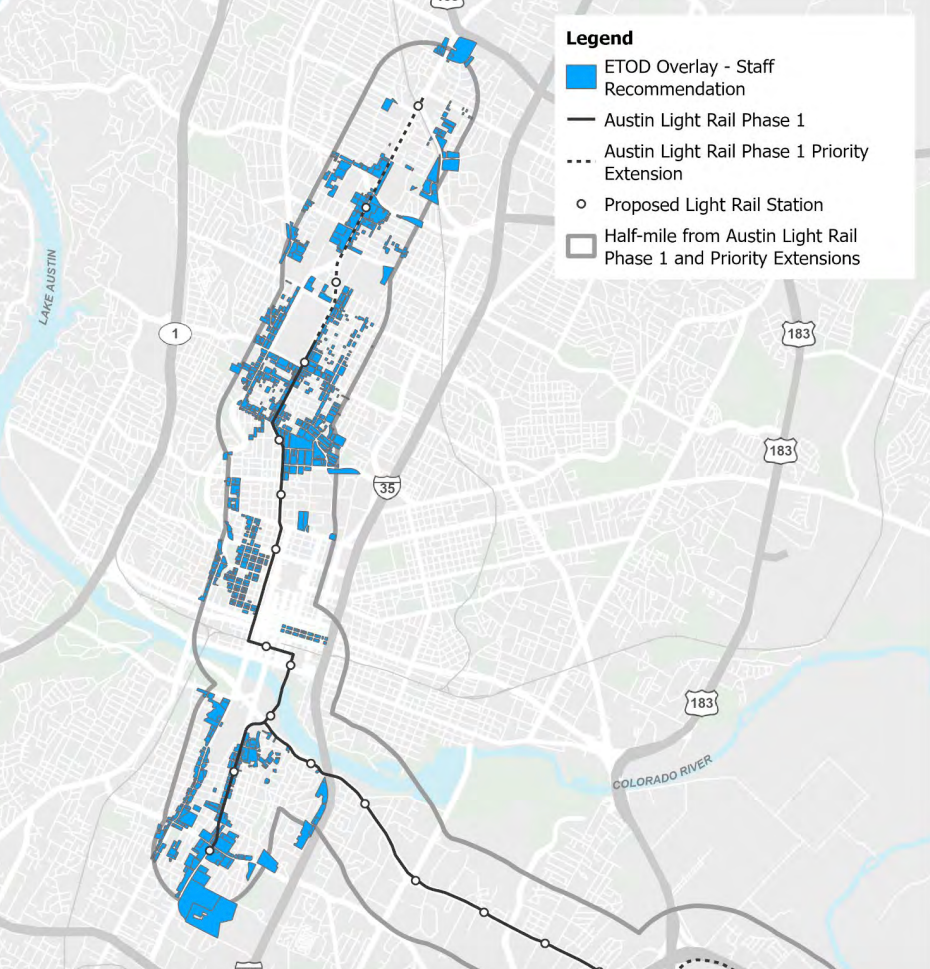
Want to know more?
The city is hosting two more open houses for the public to learn about all four of the proposed land development code changes.
- #1: 6 -8 p.m. Monday, May 6, at Anderson High School, 8403 Mesa Dr.
- #2: 6-8 p.m. Wednesday, May 8, at the George Washington Carver Museum and Cultural Center, 1165 Angelina St.
— Cat DeLaura, Reporter

Temperature: 84 degrees | Sun: Behind clouds | What to Expect: Spotty showers
A warm and cloudy day is forecast across Austin with a few spotty afternoon showers in the Hill Country. Gusty south winds continue to send moisture from the coast into Central Texas, setting the stage for more unsettled weather as we head into the weekend.
Mary’s Tip: Want to listen to some amazing jams? Check out the alt-rock band, Vaydra. They're playing a free concert at Meanwhile Brewery tonight at 8:30 p.m.

What's that sign?
Have you ever come across a “We support West Austin Park Overlook Project” sign and wondered what it is exactly your neighbor supports?
Overlook may invoke images of highways and overpasses in some of your minds, but don’t worry. It’s nothing scary like that.
There’s a section in the northwest corner of the West Austin Neighborhood Park that used to be a tennis court. All you’ll see there now is a patch of empty grass outlined by a small, barely visible concrete wall. The Friends of West Austin Park wants to create a landscaped seating area with trees and picnic tables. (See below image for an idea of what it would look like.)

“It’s really about creating an adult seating area in the park,” said Chris Schorre, the executive committee chair of the Friends of West Austin Park. “Because other than the dog park, there really is no place for adults to come, sit and relax. We wanted to create a little environment where people can have chance encounters with each other and just sit and enjoy the view.”
So how and when does this get made?
Friends of West Austin Park has city approval for the project and is working with TBG Partners to finish construction drawings by May 3. After that, the Friends will apply to the city for construction permits and get contractor bids.
The group has currently raised about $200,000 — or a third of the estimated $650,000 price tag. The money will be held by Austin Parks Foundation, a partner on the project, until the construction begins. The city has not contributed any money so far, though Schorre said he’s hopeful they still might.
So when will it all begin? That really depends on how quickly they can raise the remaining costs. Once that’s complete, he expects they could break ground six to nine months later.
“This is not just a pretty picture,” said Schorre. “We are actually completing the construction drawings and are ready to get quotes on it. … The only thing standing between us and getting this project done is the rest of the funds.”
— Cat DeLaura, Reporter
3 things to know about Oracle moving its HQ out of Austin
You know that ginormous building along the trail just east of I-35 and on the south side of the lake? That’s the headquarters for Oracle, a top dog in the cloud software world.
Well, Austin won’t be its HQ in the long run. Here’s what you need to know:
- Nashville will be Oracle’s new HQ, as CNBC reported. CEO Larry Ellison said at the Oracle Health Summit on Tuesday that the town “will ultimately be our world headquarters.”
- Why Nashville? Oracle’s been trying to delve deeper into the health care world (the “industry we’re most concerned about”), and Nashville is a major health care hub. The ~~synergy~~.
- Ellison seemed to forget that he had … casually announced his multibillion-dollar tech giant was moving its HQ across the country. After he spilled the beans, he said, “I shouldn’t have said that.”
Little late for that, Larry.
📚OK, OK!
Today's clue is for 25 Down: The closest one to Austin is in Round Rock.


We’re so glad you found us. Find our bios and contact info here, or reach out at hello@austindaily.com. Behind today’s send: Katie Canales, Cat DeLaura and Mary Wasson.
